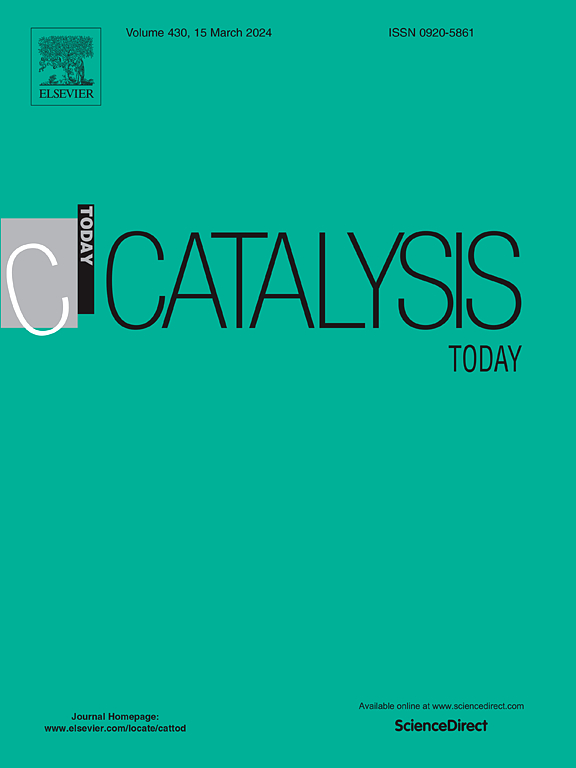Optimizing Sorption Enhanced Methanation (SEM) of CO2 with Ni3Fe + LTA 5 A mixtures
IF 5.2
2区 化学
Q1 CHEMISTRY, APPLIED
引用次数: 0
Abstract
This study investigates the integration of catalytic CO2 methanation and water adsorption using a Ni-Fe-based catalyst and LTA 5 A zeolite to enhance methane production via the Sabatier reaction. By mitigating thermodynamic limitations through in situ water removal, the research explores key operational parameters, including temperature, space velocity, and H₂:CO₂ feed ratios, to optimize process performance. The findings highlight that a temperature of 300 °C, a WHSV of 1.50 × 104 (STP) mL·gcat−1·h−1 (4.86 gCO2·gcat⁻¹·h⁻¹), and a H₂:CO₂ molar ratio equal to 5:1, result in enhanced methane yields, shifting thermodynamic equilibrium due to water sorption during initial stages. The presence of methane in the feed, representative of a biogas, demonstrated negligible effects on methane yields under optimal conditions, underscoring the method’s feasibility for direct biogas upgrading. While the process achieved significant intensification, challenges such as loss of activity of the bed of solids (catalyst plus water adsorbent) were identified, necessitating further advancements in both catalyst and adsorbent stability, as well as a deeper study on their interaction. The study provides a pathway for scaling up adsorption-enhanced methanation technologies to achieve renewable methane production, addressing the dual goals of carbon management and energy storage.
Ni3Fe + lta5 A混合物对CO2吸附强化甲烷化(SEM)的优化
本研究利用镍铁基催化剂和lta5 a沸石,研究了催化CO2甲烷化和水吸附的整合,以提高Sabatier反应的甲烷产量。通过原位除水来缓解热力学限制,研究探索了关键的操作参数,包括温度、空速和H₂:CO₂进料比,以优化工艺性能。研究结果强调,300°C的温度,1.50 × 104 (STP) mL·gcat−1·h−1(4.86 gCO2·gcat⁻¹)的WHSV, h₂:CO₂的摩尔比等于5:1,会导致甲烷产量增加,在初始阶段由于吸水而改变热力学平衡。在最佳条件下,饲料中甲烷(沼气的代表)的存在对甲烷产量的影响可以忽略不计,强调了该方法直接沼气升级的可行性。虽然该工艺得到了显著的强化,但也发现了诸如固体床(催化剂和水吸附剂)活性损失等挑战,因此需要进一步提高催化剂和吸附剂的稳定性,并对它们的相互作用进行更深入的研究。该研究为扩大吸附强化甲烷化技术以实现可再生甲烷生产提供了一条途径,解决了碳管理和能源储存的双重目标。
本文章由计算机程序翻译,如有差异,请以英文原文为准。
求助全文
约1分钟内获得全文
求助全文
来源期刊

Catalysis Today
化学-工程:化工
CiteScore
11.50
自引率
3.80%
发文量
573
审稿时长
2.9 months
期刊介绍:
Catalysis Today focuses on the rapid publication of original invited papers devoted to currently important topics in catalysis and related subjects. The journal only publishes special issues (Proposing a Catalysis Today Special Issue), each of which is supervised by Guest Editors who recruit individual papers and oversee the peer review process. Catalysis Today offers researchers in the field of catalysis in-depth overviews of topical issues.
Both fundamental and applied aspects of catalysis are covered. Subjects such as catalysis of immobilized organometallic and biocatalytic systems are welcome. Subjects related to catalysis such as experimental techniques, adsorption, process technology, synthesis, in situ characterization, computational, theoretical modeling, imaging and others are included if there is a clear relationship to catalysis.
 求助内容:
求助内容: 应助结果提醒方式:
应助结果提醒方式:


